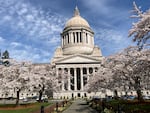
The Washington state Capitol in Olympia.
Austin Jenkins / Northwest News Network
When it comes to their own districts, Southwest Washington lawmakers say they aren’t particularly worried. At least not yet.
The redistricting process, which got underway this month, redraws legislative and congressional lines in the state. While tweaking map lines doesn’t usually electrify voters, redistricting does determine how voters are grouped and, thus, who they send to Olympia. It’s a once-in-a-decade procedure.
It’s a process rife with questions about fairness. Republicans and Democrats each selected two voting members to serve on the Washington State Redistricting Commission. The commission could finalize a map by Nov. 15.
This month, the four commissioners released their first drafts. The receptions by Southwest Washington lawmakers have run the gamut, and echoed some concerns submitted by citizens.
Senate Republican Leader John Braun, of Centralia, and Sen. Ann Rivers, a La Center Republican, both said they felt Democrats’ maps are designed to retain power. They said Republicans suggested crafting more swing districts than their counterparts, who hold majorities in both the state House and Senate.
“They were so blatantly partisan. I don’t remember a time when there was such partisanship,” Rivers said.
Accusations of gerrymandering have come up quickly. While Rivers and Braun directed their comments at districts across the state, Southwest Washington is home to multiple districts that will drive their own debates.
According to Braun, several districts in Southwest Washington have been pitched by Republicans “to be more competitive.” That includes the 17th and 18th districts, both in Clark County, and the 19th district, which sweeps from the cities of Longview to Long Beach.
Braun’s district, the 20th, today blankets Cowlitz, Lewis and parts of Thurston counties. Some proposals have it stretching further south into Clark County, but he said he predicts it will actually kick to the north more into Thurston.
“I’d like to keep as much of my district as possible,” he said. “I have relationships with them. I understand their concerns.”
How districts deal with suburban areas will be scrutinized. The redistricting process aims to provide each district the same size populations. Striking that balance means commissioners will constrict the lines for urban districts and expand the landmass of rural ones.
The 49th district, which encompasses Vancouver’s growing downtown, is likely to shrink. But, for the nearby 17th and 18th districts, the drafts vary wildly. Some have either of the districts shrinking into the city while the other balloons into the heavily forested Skamania County. (In Washington, House and Senate districts follow the same maps. Each district has two members of the state House and one Senator.)
Rep. Monica Stonier, a Vancouver Democrat from the 49th district, said she hoped the final drafts will do a better job of linking county residents together.
“If I live in a city east of Vancouver and my legislator represents Skamania and east of that … what can I talk to them about as a school board member or as a parent of a kid in school? How is it going to matter when most of their experience is out of the county?” Stonier said.
Two drafts call for the 14th district — spanning Klickitat and Yakima counties — to push westward and envelop Clark County’s suburban cities of Camas and Washougal. Voters there, who today vote alongside Yacolt, Ridgefield and La Center, would instead vote alongside Goldendale and White Salmon.
Sen. Annette Cleveland, also of the 49th, said she would make the case for the 17th district to represent Camas and Washougal. But she also said she understood the argument for pulling in more Columbia River Gorge communities.
“The people in the Gorge are very much connected to Vancouver and, oftentimes, to the Oregon cities that are across (the Columbia River) from them,” Cleveland said.
Local economies are also a factor. The 14th district, for example, encompasses numerous fruit processing plants in Yakima as it does a burgeoning high-tech drone industry in Bingen. Its southern communities reap the financial benefits of Portlanders traveling into the Gorge.
“More and more, our economy depends upon high-tech industries, which in turn depend upon transportation corridors to the Vancouver-Portland region,” Klickitat County resident Rick George wrote to the redistricting commission on July 26. “Our media hub is in the Vancouver-Portland region. In turn, many residents in the Vancouver-Portland metro area frequent our county for its numerous recreation opportunities.”
For coastal communities, which often rely on tourism and trade, Rep. Jim Walsh, a Republican from Aberdeen, said it made sense for the 19th district to continue representing industrial ports. And he took issue with a proposal that would put a paper mill in Cosmopolis out of his district.
“It benefits by being in the 19th with some larger pulp mills, and it kind of glide on their public policy lobbying,” Walsh said. “You leave it by itself in a new legislative district.”
But the politicking will continue. Walsh called the Democrats’ first maps only opening salvos — some of which, in fact, would force him to move if he wanted to continue representing the 19th district. But he didn’t expect that aspect to make it to the final vision.
“Remember: the politics of the final product is endlessly complicated,” Walsh said.
Rep. Sharon Wylie, of the 49th district, disputed that the Democrats’ proposals are less competitive. Instead, she said the redistricting process might just show that it’s getting harder to be a conservative in Washington state.
“The reality is that our state is pretty darn blue. Rural conservative areas are becoming less conservative,” Wylie said. “In order to make districts more competitive, you’d really have to gerrymander them.”